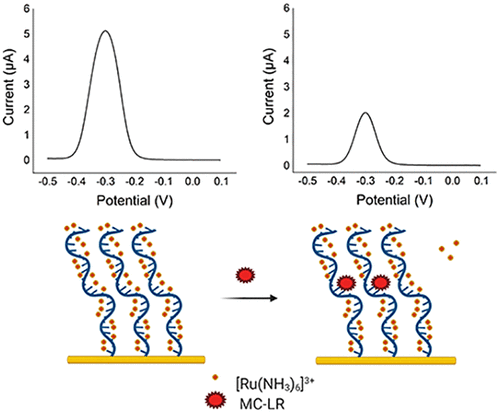当前位置:
X-MOL 学术
›
ACS ES&T Eng.
›
论文详情
Our official English website, www.x-mol.net, welcomes your feedback! (Note: you will need to create a separate account there.)
Sensitive Electrochemical Detection of Microcystin-LR in Water Samples Via Target-Induced Displacement of Aptamer Associated [Ru(NH3)6]3+
ACS ES&T Engineering Pub Date : 2021-09-05 , DOI: 10.1021/acsestengg.1c00256 Vasileia Vogiazi 1 , Armah de la Cruz 2 , Eunice A Varughese 2 , William R Heineman 3 , Ryan J White 3, 4 , Dionysios D Dionysiou 1
ACS ES&T Engineering Pub Date : 2021-09-05 , DOI: 10.1021/acsestengg.1c00256 Vasileia Vogiazi 1 , Armah de la Cruz 2 , Eunice A Varughese 2 , William R Heineman 3 , Ryan J White 3, 4 , Dionysios D Dionysiou 1
Affiliation

|
In this study, we demonstrate the successful development of an electrochemical aptamer-based sensor for point-of-use detection and quantification of the highly potent microcystin-LR (MC-LR) in water. The sensor uses hexaammineruthenium(III) chloride ([Ru(NH3)6]3+) as redox mediator, because of the ability of the positively charged (3+) molecule to associate with the phosphate backbone of the nucleic acids. We quantitatively measure the target-induced displacement of aptamer associated, or surface confined, [Ru(NH3)6]3+ in the presence of MC-LR. Upon the addition of MC-LR in the water, surface-confined [Ru(NH3)6]3+ dissociates, resulting in less faradaic current from the reduction of [Ru(NH3)6]3+ to [Ru(NH3)6]2+. Sensing surfaces of highly packed immobilized aptamers were capable of recording decreasing square wave voltammetry (SWV) signals after the addition of MC-LR in buffer. As a result, SWV recorded substantial signal suppression within 15 min of target incubation. The sensor showed a calculated limit of detection (LOD) of 9.2 pM in buffer. The effects of interferents were minimal, except when high concentrations of natural organic matter (NOM) were present. Also, the sensor performed well in drinking water samples. These results indicate a sensor with potential for fast and specific quantitative determination of MC-LR in drinking water samples. A common challenge when developing electrochemical, aptamer-based sensors is the need to optimize the nucleic acid aptamer in order to achieve sensitive signaling. This is particularly important when an aptamer experiences only a small or localized conformational change that provides only a limited electrochemical signal change. This study suggests a strategy to overcome that challenge through the use of a nucleic acid-associated redox label.
中文翻译:

通过适体相关 [Ru(NH3)6]3+ 的靶诱导置换对水样中的微囊藻毒素-LR 进行灵敏的电化学检测
在这项研究中,我们展示了一种基于电化学适配体的传感器的成功开发,用于使用点检测和定量水中的高效微囊藻毒素-LR (MC-LR)。该传感器使用氯化六氨合钌 (III) ([Ru(NH 3 ) 6 ] 3+ ) 作为氧化还原介质,因为带正电荷的 (3+) 分子能够与核酸的磷酸盐骨架结合。我们定量测量了在 MC-LR 存在下,目标诱导的适配体相关的或表面受限的 [Ru(NH 3 ) 6 ] 3+的位移。在水中加入 MC-LR 后,表面受限的 [Ru(NH 3 ) 6 ] 3+解离,导致 [Ru(NH 3 ) 6 ] 3+还原为 [Ru( NH 3 ) 6 ] 2+的法拉第电流减少. 在缓冲液中加入 MC-LR 后,高度填充的固定适配体的传感表面能够记录递减的方波伏安 (SWV) 信号。因此,SWV 在目标孵育 15 分钟内记录到大量信号抑制。传感器在缓冲液中显示计算出的检测限 (LOD) 为 9.2 pM。干扰物的影响很小,除非存在高浓度的天然有机物 (NOM)。此外,该传感器在饮用水样品中表现良好。这些结果表明传感器具有快速和特异性定量测定饮用水样品中 MC-LR 的潜力。在开发基于适体的电化学传感器时,一个常见的挑战是需要优化核酸适体以实现灵敏的信号传导。当适体仅经历小的或局部的构象变化而仅提供有限的电化学信号变化时,这一点尤其重要。这项研究提出了一种通过使用核酸相关氧化还原标记来克服这一挑战的策略。
更新日期:2021-11-12
中文翻译:

通过适体相关 [Ru(NH3)6]3+ 的靶诱导置换对水样中的微囊藻毒素-LR 进行灵敏的电化学检测
在这项研究中,我们展示了一种基于电化学适配体的传感器的成功开发,用于使用点检测和定量水中的高效微囊藻毒素-LR (MC-LR)。该传感器使用氯化六氨合钌 (III) ([Ru(NH 3 ) 6 ] 3+ ) 作为氧化还原介质,因为带正电荷的 (3+) 分子能够与核酸的磷酸盐骨架结合。我们定量测量了在 MC-LR 存在下,目标诱导的适配体相关的或表面受限的 [Ru(NH 3 ) 6 ] 3+的位移。在水中加入 MC-LR 后,表面受限的 [Ru(NH 3 ) 6 ] 3+解离,导致 [Ru(NH 3 ) 6 ] 3+还原为 [Ru( NH 3 ) 6 ] 2+的法拉第电流减少. 在缓冲液中加入 MC-LR 后,高度填充的固定适配体的传感表面能够记录递减的方波伏安 (SWV) 信号。因此,SWV 在目标孵育 15 分钟内记录到大量信号抑制。传感器在缓冲液中显示计算出的检测限 (LOD) 为 9.2 pM。干扰物的影响很小,除非存在高浓度的天然有机物 (NOM)。此外,该传感器在饮用水样品中表现良好。这些结果表明传感器具有快速和特异性定量测定饮用水样品中 MC-LR 的潜力。在开发基于适体的电化学传感器时,一个常见的挑战是需要优化核酸适体以实现灵敏的信号传导。当适体仅经历小的或局部的构象变化而仅提供有限的电化学信号变化时,这一点尤其重要。这项研究提出了一种通过使用核酸相关氧化还原标记来克服这一挑战的策略。



























 京公网安备 11010802027423号
京公网安备 11010802027423号